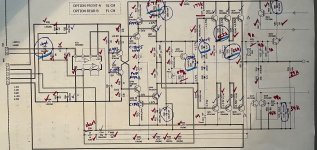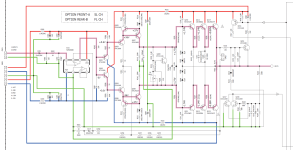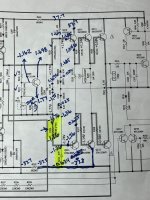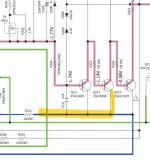Quick question, as I have gone through this problematic amp channel at least three times now.
Bought a basket-case MM7055 that I wanted to try and refurbish for a friend. Opened it up and the outputs, a couple Caps, a diode and some resistors were bad. No problem, put in some MJL4281/4302 for outputs and replaced the other parts per the schematic. Went through and checked every resistor, diode, capacitor and transistor in the circuit and also compared to the channel right next to it on the PCB (it works fine and bias' up without any issues). I also checked the variable resistors and they go from ~700r to 0.3r range, and consistent with the adjacent channel.
Strange part is that I get music and it sounds fine. the issue is I can only get it to bias to 0.65mV, when the service manual spec is 1.5mV. this is across 0.1r emitter resistors, so I should have ~15mA and I'm only able to get ~6.5mA. As I mentioned it plays music fine, no issues and I can't really "hear" any difference in my HT room playing music through the repaired channel and any of the other 4 channels.
I have gone back in 3 times and even changed the MJL outputs to original TO-200s, because I thought that might be the issue. Same problem, very little to no bias.
Any idea where to start looking, I pulled Q209 out of circuit and tested with the adjacent channel's Q209 - they tested 99% the same. I retested all the resistors in that vicinity and they all test good and any outside tolerance, were compared again to the adjacent channel and the two match ~95% (for resistance or diode voltage drop)
I have attached the schematic and the parts "circled" have been replaced with new parts from Mouser. The outputs were MJL4281/4302, now NOS 2Sa1216/C2922 (known trusted seller). Anyone want to give this a fresh set of eyes and possibly point me in a direction for parts that might be causing the no bias?
Bought a basket-case MM7055 that I wanted to try and refurbish for a friend. Opened it up and the outputs, a couple Caps, a diode and some resistors were bad. No problem, put in some MJL4281/4302 for outputs and replaced the other parts per the schematic. Went through and checked every resistor, diode, capacitor and transistor in the circuit and also compared to the channel right next to it on the PCB (it works fine and bias' up without any issues). I also checked the variable resistors and they go from ~700r to 0.3r range, and consistent with the adjacent channel.
Strange part is that I get music and it sounds fine. the issue is I can only get it to bias to 0.65mV, when the service manual spec is 1.5mV. this is across 0.1r emitter resistors, so I should have ~15mA and I'm only able to get ~6.5mA. As I mentioned it plays music fine, no issues and I can't really "hear" any difference in my HT room playing music through the repaired channel and any of the other 4 channels.
I have gone back in 3 times and even changed the MJL outputs to original TO-200s, because I thought that might be the issue. Same problem, very little to no bias.
Any idea where to start looking, I pulled Q209 out of circuit and tested with the adjacent channel's Q209 - they tested 99% the same. I retested all the resistors in that vicinity and they all test good and any outside tolerance, were compared again to the adjacent channel and the two match ~95% (for resistance or diode voltage drop)
I have attached the schematic and the parts "circled" have been replaced with new parts from Mouser. The outputs were MJL4281/4302, now NOS 2Sa1216/C2922 (known trusted seller). Anyone want to give this a fresh set of eyes and possibly point me in a direction for parts that might be causing the no bias?
Attachments
I have between 3.2-4.06 across CE (7.75k resistance w no power) on Q209, voltages does vary turning the pot.
These voltages are taken at min resistance on pot, CE is ~4.05V.
B: -1.810
C: 1.723
E: -2.336
Edit: not sure it helps but I dialed in the emitter to -1.77v and the collector becomes 1.698, base is -1.162 and CE is 3.462.
Thanks
These voltages are taken at min resistance on pot, CE is ~4.05V.
B: -1.810
C: 1.723
E: -2.336
Edit: not sure it helps but I dialed in the emitter to -1.77v and the collector becomes 1.698, base is -1.162 and CE is 3.462.
Thanks
Last edited:
I knew I just needed to step away and get a member of DIYaudio team to point me in the right direction. Thanks Jon!
Started marking out voltages (see pic) and couldn’t figure out why R224 was dropping -0.40v when the positive rail dropped 0.0, then I was puzzled why C211 had -0.634v where it should have -37.7v.
Tested best I could in circuit and both R and C tested ok. No choice but to remove the amp board (for the 7th time) and look at the soldering.
What do you know the Collector of Q213 had a torn pad so the connection back towards R222 was OL. Made a bridge between those two points, checked the areas resistance vs adjacent channel and they matched.
Put it back together and I have Bias, and it’s stable for more than 10 mins. I’ll keep warming it up and do a final setting and then listen to some music - see if I notice any difference in the sound???
Couple pics to illustrate the issue and voltages I had, might help someone in the future, since I only found one thread around repairing one of these.
Started marking out voltages (see pic) and couldn’t figure out why R224 was dropping -0.40v when the positive rail dropped 0.0, then I was puzzled why C211 had -0.634v where it should have -37.7v.
Tested best I could in circuit and both R and C tested ok. No choice but to remove the amp board (for the 7th time) and look at the soldering.
What do you know the Collector of Q213 had a torn pad so the connection back towards R222 was OL. Made a bridge between those two points, checked the areas resistance vs adjacent channel and they matched.
Put it back together and I have Bias, and it’s stable for more than 10 mins. I’ll keep warming it up and do a final setting and then listen to some music - see if I notice any difference in the sound???
Couple pics to illustrate the issue and voltages I had, might help someone in the future, since I only found one thread around repairing one of these.



